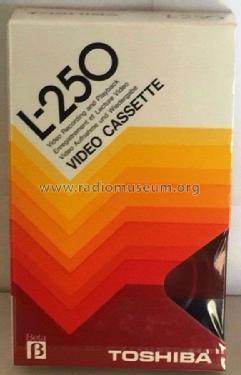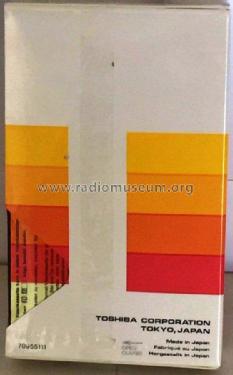Beta ß Video Cassette All
Toshiba Corporation; Tokyo
- Land
- Japan
- Hersteller / Marke
- Toshiba Corporation; Tokyo
- Jahr
- 1975
- Kategorie
- Diverses (Sonstiges) - siehe Bemerkungen
- Radiomuseum.org ID
- 265732
-
- anderer Name: Shibaura Engineering Works
- Marke: Tokyo Shibaura
- Wellenbereiche
- - ohne
- Spezialitäten
- Spezialband- oder -Kassette
- Betriebsart / Volt
- Keine Stromversorgung
- Lautsprecher
- - - Kein Ausgang für Schallwiedergabe.
- Material
- Plastikgehäuse (nicht Bakelit), Thermoplast
- von Radiomuseum.org
- Modell: Beta ß Video Cassette [All] - Toshiba Corporation; Tokyo
- Form
- Diverse Formen, unter Bemerkung beschrieben.
- Abmessungen (BHT)
- 156 x 96 x 25 mm / 6.1 x 3.8 x 1 inch
- Bemerkung
-
This page is for all TOSHIBA labeled Beta ß (Betamax) type Video Cassette tapes for all Analog TV standards.
Please do not modify this page.
Load only pictures with all data in the picture legend!
Bitte nur Bilder hochladen, alle Informationen/Daten in die Bildlegende.
History (Extracts taken from Wikipedia):
"Betamax (also called Beta, and referred to as such in the logo) is a consumer-level analog videocassette magnetic tape recording format developed by Sony, released in Japan on May 10, 1975.
The cassettes contain .50 in (12.7 mm)-wide videotape in a design similar to the earlier, professional .75 in (19 mm) wide, U-matic format.
The format is virtually obsolete, having lost the videotape format war though an updated variant of the format, Betacam, is still used by the television industry.
Like the rival videotape format VHS (introduced in Japan by JVC in October 1976 and in the United States by RCA in August 1977, Betamax had no guard band and used azimuth recording to reduce crosstalk.
beta being the Japanese word used to describe the way signals were recorded onto the tape, and from the fact that when the tape ran through the transport, it looked like the Greek letter beta (β). The suffix -max, from the word "maximum", was added to suggest greatness.
In 1977, Sony came out with the first long play Betamax VCR, the SL-8200. This provided two hours recording time on the L-500 Beta videocassette. The SL-8200 was to compete against the VHS VCRs that had 2 or 4 hours of recording time.
Sanyo marketed a version as Betacord, but this was also referred to casually as "Beta". In addition to Sony and Sanyo, Beta-format video recorders were also sold by Toshiba, Pioneer, Murphy, Aiwa, and NEC; the Zenith Electronics Corporation and WEGA Corporations contracted with Sony to produce VCRs for their product lines. Department stores like Sears (in the United States and Canada) and Quelle (Germany) sold Beta-format VCRs under their house brands, as did the RadioShack chain of electronic stores. Betamax and VHS competed in a fierce format war, which saw VHS come out on top in most markets."
"Betamax ist der Markenname eines von Sony in den siebziger Jahren entwickelten Halbzoll-Magnetbandsystems zur Aufzeichnung von analogen Video- und Audiosignalen. Betamax wurde für den Endverbrauchermarkt entwickelt und erschien 1975 erstmals in den USA und Japan auf dem Markt .
Die Einführung in der Bundesrepublik Deutschland erfolgte 1978. Betamax-Anbieter waren Sony (Systementwickler), Fisher, NEC, Sanyo, Toshiba und Wega. Betamax konnte sich im Formatkrieg nicht gegenüber VHS von JVC durchsetzen...
Das handelsübliche Standardformat war die L-750-Kassette, die eine Spielzeit von 195 Minuten hat. Weniger verbreitet war die L-830 mit einer Maximallaufzeit von 215 Minuten. Weitere Formate sind L-125 (30 Minuten), L-165 (45 Minuten), L-250 (65 Minuten), L-370 (95 Minuten) und L-500 (130 Minuten). Die Zahl steht dabei für die Länge des Bandes in Fuß.
Die Bandtransportgeschwindigkeit betrug in Deutschland bei Betamax (PAL) 1,95 cm/s. Das entspricht bei einer Breite des Bandes von einem halben Zoll wiederum etwa 2,5 cm²/s. Zum Vergleich die VHS (PAL/SP) Bandtransportgeschwindigkeit: 2,34 cm/s. Das entspricht bei der Breite des Bandes von einem halben Zoll etwa 2,97 cm²/s. VHS hatte eine um 20 % geringere Speicherdichte und verbrauchte somit 20 % mehr Bandmaterial pro Spielzeit. Der Betamax-Standard stellt auch die Möglichkeit zur Verfügung, neben dem HiFi-Stereoton PCM-codierten digitalen Ton aufzuzeichnen. Manche Geräte haben somit fünf Tonkanäle (Mono-Längsspur, HiFi links und rechts, PCM links und rechts)."
- Autor
- Modellseite von einem Mitglied aus A angelegt. Siehe bei "Änderungsvorschlag" für weitere Mitarbeit.
- Weitere Modelle
-
Hier finden Sie 999 Modelle, davon 923 mit Bildern und 214 mit Schaltbildern.
Alle gelisteten Radios usw. von Toshiba Corporation; Tokyo

